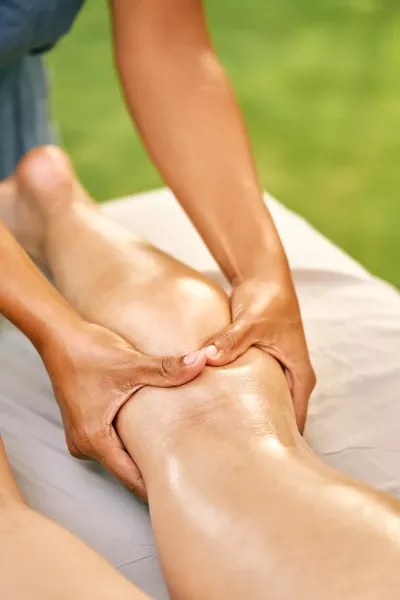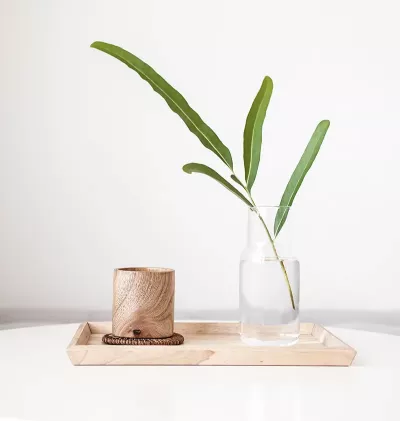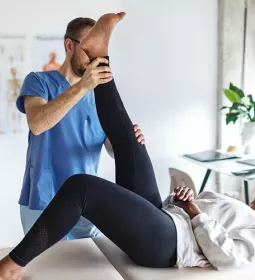Massage therapists are helpers. We want to make the lives of each client better. We want to do whatever we can to be of service. But our good intentions, as I have explored in various articles in Massage & Bodywork magazine over the last decade, can have unintended consequences.1 Your eagerness to help does not always help—and sometimes might even harm—your clients. That is especially true when it comes to pain.
The Problem
Life’s aches and pains are a primary reason why people get massage. And if we are doing our jobs right, our clients leave our treatment rooms feeling better than when they arrived. But we can, and should, be doing more. I believe our profession is held back by outdated ideas about pain, and too often we are perpetuating in our clients a counterproductive understanding of their own pain and tension. I say all this with no judgment, only love. Like most of our profession’s problems—from our exceptional rates of burnout to our tendency to diagnose and otherwise evade our scope-of-practice guidelines—this problem emerges from our good intentions. But that makes it both a more challenging, and more urgent, problem to try to solve.

Think about the language we use. We talk with clients about “taking away” their pain. About “getting rid” of their knots. About “extinguishing” their trigger points. The idea is alluring (for us and for our clients): If we just work hard enough, we can banish pain and knots and tension from another person’s body. We can cure our clients of all that ails them. And who among us doesn’t want to be able to cure another person of all that ails? But that idea is an illusion, and a very problematic one.
I want to offer an alternate way, using the recent insights of pain science, for us to think about and work with pain—and an alternate way to talk with our clients about it. First, we must accept that pain is an inevitable—and beneficial—part of being alive. Therefore, getting rid of pain is impossible and unhelpful. Next, instead of perpetuating a faulty and simplistic notion of the body, we need to help our clients embrace all aspects of themselves, including the painful parts, to help them inhabit their bodies more fully.
The Reality
We are people of the body. We love muscles. We get pretty excited about tendons and ligaments and joints too. But ask a massage therapist what their least favorite class in massage school was, and there’s a good chance the response will come without pause: neurology. This is a generalization, of course, but I think it is a revealing one. Our understanding of the body is shaped by what we can palpate with our hands. The other stuff isn’t quite as resonant for us. No surprise then, that our understanding of pain follows suit.
My guess is that for many of us, our understanding of pain looks something like those diagrams in our Human Anatomy & Physiology textbook from the first semester of massage school. A cartoon drawing of a person alongside a “noxious stimulus” (anything that can damage tissue)—perhaps a hot stove or a punch in the gut or the thin slice of a paper cut; an ascending neuron relays that painful sensation to the brain; the brain registers danger and initiates the appropriate response (jerking the hand away from the stove, etc.) via a descending neuron, thus avoiding further pain and preventing injury.2 This is what pain scientists refer to as the “bottom up” theory of pain. (And we therapists are not alone: This is how most humans, I’m guessing, still think about pain.)

To be clear, this explanation is entirely accurate. But it is also woefully inadequate. With most pain—from that ankle you sprained playing soccer, to that crick in your neck when you sleep in a funny position, to the dull ache in your forearms after a long day on the computer—there is indeed some kind of noxious stimulus, and then your brain decides how to respond. And yet, this is just one small part of what is actually happening when you hit the turf wrong or wake up drooling in a strange position. For the last half-century, the growing field of pain science has been revealing the startling complexity of what pain really is—from Ronald Melzack’s field-shaping notion of the Gate Theory of Pain in the 1960s to today’s efforts by Lorimer Moseley and a number of others to “explain pain” to an increasingly desperate public.3
The wonderful science writer Paul Ingraham sums up our predicament nicely: “Injury and pain are not in lockstep with each other. And yet that is exactly what nearly everyone assumed for a long, long time. And many professionals, even though they may ‘know’ better, often seem to forget how powerfully pain is influenced by perception, context, and meaning.”4 This is where things start to get messy. Pain is a tricky concept because it seems so obvious. Often, we can point to it—my hip hurts right here. Our old explanations have endured for so long because they seem obvious and self-evident. I can point to my pain, so there must be something wrong right here. There must be some kind of damage, right here. But the more we know, the less we realize that is the case.
In the last few decades our definitions of what pain really is have evolved and gotten ever more abstract, tentative, and hesitant. Take the current definition of pain from the International Association for the Study of Pain (IASP): “An unpleasant sensory and emotional experience associated with, or resembling that associated with, actual or potential tissue damage.”5
Confused yet? You are not alone.
Notice in the IASP definition that pain is an “emotional experience” as much as it is a sensory one. And see the careful caveat: Pain doesn’t guarantee tissue damage of any kind. It might just be “resembling that associated with” an actual problem in your actual tissues. (Furthermore, pain can even come from something that hasn’t happened yet—merely from anticipating what is going to happen—from “potential tissue damage”!)
What we must reckon with is that we can’t look solely to the muscles and tendons and joints and ligaments and fascia to understand the pain a client is feeling. We have to look at the whole body—and the whole mind in particular—and as a result, at that person’s beliefs and biases, their experiences and expectations. The experience of pain, in other words, is created not (just) by your hand touching a hot stove, but by the vast stew of human life.
From this broadened perspective, the possible sources of a specific pain seem nearly endless. And overwhelming. We can no longer say that a client feels pain just because of this knot or that trigger point, or just because they cross their legs while they sit at their desk all day, or just because they slump their shoulders forward while they are driving, or . . . Of course, all these explanations may well be accurate, but at most, they will only be one part of the explanation.
While this can feel deflating—you mean I can’t fix my client just by pressing on a trigger point?—it should also be a relief. Surely you have been stymied by those clients who don’t seem to get better, no matter how many awesome techniques you try. Pain science provides an explanation. Typical injuries tend to heal on their own; pain spikes when the problem is acute, and then diminishes. But other times, something very different happens. An acute injury becomes a chronic pain. Or an occasional ache becomes a perpetual one. It doesn’t go away. And we now know that’s not because of the tissue in that injured area—it is because of the brain, which has become overly sensitized to new pain, and as a result, protects and anticipates and perpetuates the feeling of pain.
Physical therapist Anoop Balachandran describes the process this way: “This hypersensitivity causes the brain to interpret anything related to those tissues to be highly threatening. Just like the concept ‘The more you practice, the better you become at performing the skill,’ the longer your pain persists, the more efficient the nervous system and the brain become in triggering and maintaining pain. Hence in chronic pain, pain has moved up to the nervous system and now has very little to do with the initial damage to the tissues that caused the pain.”6
The brain, we might say, is the fulcrum of all the pain we experience (and all our other feelings, good and bad). But this is where we must be very, very clear. Yes, it is possible that the pain in your lower back isn’t from actual tissue damage, but rather because you are anticipating an injury, or because a previous injury has sensitized that area, or because of some conglomeration of beliefs and fears swirling through your unconscious. But that doesn’t mean the pain isn’t real. As Todd Hargrove puts it, “An important reminder and caveat: Even when the brain is a major player in pain, this does not imply that pain is ‘in your head,’ that pain is your fault, that you can just think pain away, or that the body doesn’t matter.”7
Even though we all know the body is astonishingly complex, and we in the healing arts field insist that we honor every part of that complexity, we still fall prey to this reductive—and invariably judgmental—notion that if pain is in our brain, it isn’t real or valid. This is absurd. But it’s something our clients also fall victim to. We will explore how to overcome that false notion in ourselves, because only then can we help clients overcome that notion too.
Ingraham offers a useful perspective here: “The brain is not just a passive, gullible receiver for whatever messages the peripheral nerves send upstairs. And, if you think about it, it’s kind of strange that we would ever have thought of it that way, because this is, after all, the brain we’re talking about: seat of consciousness, the generator of your reality. Brains critically evaluate all the danger messages and put them in context before deciding how seriously to take the situation.”8 The fact that pain is partially—or even largely—generated by our brains doesn’t mean the pain doesn’t exist or shouldn’t be taken seriously. After all, our brains are arguably the most marvelous bundle of atoms in the known universe—capable of writing symphonies and cultivating civilizations and perfecting frozen pizza. Of course the brain is also involved in the process of pain!

Recognizing the central role of the brain in pain can help us both treat our clients more effectively and help our clients see themselves with greater compassion. When a client is in the throes of persistent pain—whether from that lingering tension in the lower back or the more consuming fatigue of fibromyalgia—we can help them see there is nothing “wrong” with their body. There is no trigger point that needs to be pressed out of existence, and no physiological process that is bad. Rather, there is the seat of consciousness, doing its best to protect its host, and sometimes going a little haywire.
The sympathetic branch of our autonomic nervous system—the “fight, flight, or freeze” portion—has taken over and is sensing a threat where there is none, gearing up for a fight against an imagined foe. Those efforts have gone too far and have in turn caused other problems, but at heart, the only “problem” here is the client’s brain trying to care for itself the best way it knows how. We will only be able to work with the haywire version of pain when we can appreciate how essential pain is. We need to treat this part of our body with kindness and appreciation rather than as some sort of demon we are trying to exorcise.
The Solution
I find the ongoing revelations of pain science utterly fascinating. But they are only truly valuable if we can figure out how to integrate them into what we are actually doing (and not doing) with our clients. Let’s explore how this evolving understanding can (and should) alter the choices we make in our work. As with any meaningful therapeutic intervention, the way we see ourselves and think about ourselves is as important as the way we think about and work with the client. Shifting our own thinking is always the first—and often the hardest—step.
Shift Yourself
Let’s start by committing to evolve our own understanding of pain. The first part is intellectual and relatively simple. Read more, watch more, learn more. The clear and compelling writings and lectures of Lorimer Moseley, Paul Ingraham, and Dianne Jacobs are easy places to get started. The second, trickier part is to shift the way we think about our own aches and pains and discomfort. We need to practice what we preach. What are the counterproductive stories you tell about your own body? Notice the ways in which you judge yourself and blame yourself and are unkind to yourself. Notice the things you tell your clients not to do but that you do yourself. Acknowledge the astounding complexity of the experience of being in your own body. Commit to offering that body more empathy; experiment with adjusting your own narrative about yourself. This is a lifelong process, of course, not a to-do item that can be checked off. But your work with clients will only be transformative if you can also transform your relationship with yourself.
Attend to Your Approach
We tend to pay too much attention to the particular modalities we use, and not enough attention to, well, everything else that happens during our time with a client. Once we believe that a massage shouldn’t be just digging into tight muscles, we can approach our work more expansively. Your best work will emerge when you attend to the client’s whole being—and in particular, to their nervous system—and when you remain aware of your whole being. Your mere presence has an immense impact on the client, for better or for worse. You can be rushed and loud and uncaring, and unintentionally heighten the very conditions that cause the client to anticipate pain. Or you can be calm and receptive and empathetic, and intentionally heighten the conditions that soothe them and create the conditions where change is possible. Commit yourself to an honest assessment of how you present yourself. Practice making yourself into what Maxi Miciak calls a “safe therapeutic container,” defined by being present and receptive and committed to each client.9 Ultimately, I think how we work may be less important than what we do.
An interesting reminder of the limits of specific modalities—and the power of our presence—is the surprising effectiveness of placebos. Brian Fulton has written a whole book about the placebo effect. He argues, “If our hands were actually ‘doing’ something, then a sham treatment wouldn’t be as effective. And yet, in study after study, these sham treatments hold up surprisingly well against the actual best efforts of the manual therapist.”10 Fulton calls this a “humbling” reality, and at first glance, it seems to devalue our work. But there is another, opposing possibility: that everything else we do in the treatment—beyond our actual hands-on techniques—is just as important, just as influential, as the techniques themselves. That means all the other ways we engage our client can also help that client feel better (or worse).
In other words, whether we like it or not, before we touch (and while we touch) our clients, we influence the way they see themselves and what they see as possible. We need to use that power to reinforce that they have a role in the happiness of their own bodies. Here is Til Luchau, summarizing the recent findings of physical therapist Mark Bishop and others: “In studies of cervical, shoulder, and lumbar complaints, patients’ general expectation of recovery has been repeatedly found to be the strongest predictor of recovery; stronger than the therapeutic method used, practitioner experience, or other factors.” With this in mind, “our skills at building an alliance and keeping clients engaged are probably more important to pain recovery than any particular method or therapy.”11
Prioritize the Autonomic
The most compelling takeaway from pain science is also the hardest for us to implement: The muscles aren’t nearly as central to how our clients feel as we think they are. The brain’s essential role in shaping the experience of pain means we must reckon with the overriding importance of the nervous system. That doesn’t mean we should stop massaging, only that we should approach our sessions differently. Paul Ingraham, a former massage therapist, offers a concise way forward:
Start by not focusing exclusively on “fixing” patients’ tissues. Often the problem is not the tissues, but a pain experience spinning out of control. Even when there is a tissue issue, it’s all too possible that fixing it is just impossible, that all the “tools” (treatment modalities) are largely useless, either entirely ineffective or, at the least, less important than neurology.12
He continues:
The main solution . . . is to address the patient’s nervous system. Be kind to it. Help patients remember what it’s like to feel safe and good. Be the source of a positive sensory experience. Choose and exploit modalities not for their barely-there power to change/fix tissues, but for their power to comfort and soothe, to reframe sensory experiences.13
We must be vigilant about staying within our scope of practice and not veering into the realms of talk therapy, but we can make the client feel “safe and good” both in the environment we create and in our hands-on work. Lorimer Moseley puts this challenge to us in extremely simple terms: “To reduce pain, we need to reduce credible evidence of danger and increase credible evidence of safety.”14
The way we do that is by engaging the autonomic nervous system (ANS). We want to stimulate the parasympathetic branch (known as the “rest and digest” response) and tone down the sympathetic branch (the “fight, flight, or freeze” response, which is nearly always overactive when we’re in pain). This part of our body is largely instinctual, following deeply laid neural pathways and unconscious impulses. We can’t talk someone out of their pain any more than you can command your kid to stop worrying about the monster that is surely under their bed. But our bodywork is valuable precisely because the ANS can’t be reasoned with; these unconscious impulses manifest throughout the body, and so we can use the body to turn down the volume of the sympathetic branch, to replace the deep-set instinct to fight or flee or freeze (and the pain that results) with the embodied reality of safety.
The notion of engaging the brain as well as the body can seem daunting at first. But take small steps. You can make an impact in any and all of the ways you engage with a client—emotionally, verbally, and physically. The possibilities are so numerous that you can experiment with making small shifts in all aspects of your practice, from the lights and sounds in your treatment room to the way you ask intake questions to the particular strokes you do and how you do them.
Keep on Massaging!
Nothing in this article should discourage you. Our massage work is still useful and valid and wonderful! What pain science shows is that what is happening when you do myofascial release, or the reasons why Swedish massage can feel so good, might be different than what we have long assumed. But our hands-on work is still just as important. As Todd Hargrove reminds us, “Understanding the role of the brain does not mean neglecting the role of the body.”15

There is no reason why any of the modalities you currently use are inherently wrong or bad or problematic within this more advanced understanding of pain. There is no need for you to stop what you’re currently doing. But chances are you could use those modalities even more effectively by tweaking your approach and your intentions.
Here’s how I now see my work: I am manipulating the muscles (and skin, and fascia, and tendons, and joints) in order to impact the nervous system. Whether I am offering gentle shoulder mobilization to an elderly client or deep-tissue strokes into the glutes of a dancer, my aim is to have an impact without triggering the warning alarm that is the client’s sympathetic nervous system. This approach is the foundation of my “pour, don’t push” concept, and it underlies all the continuing education classes I teach.
The most obvious takeaway from pain science is that there is no benefit, and much drawback, to intentionally causing pain while we work. Our profession valorizes aggressive work; our nervous systems hate it. Your clients will make more progress—and your own body will be happier—if you work with their bodies, rather than against them.
The possibilities are so numerous that you can experiment with making small shifts in all aspects of your practice, from the lights and sounds in your treatment room to the way you ask intake questions to the particular strokes you do and how you do them.
I still work very deeply, but intentionally. I aim for a “delicious discomfort” with my clients, not pain. And I ensure the right amount of pressure by maintaining an awareness of their breathing patterns during the session: I want the client to always be able to slowly and easily exhale during a stroke. A short breath or a sudden inhalation are signs I am working too deeply or too quickly, and thus setting off that alarm. Just as important, I lengthen my own exhalation as I work, which stimulates the other half of the ANS—the parasympathetic, or “rest and digest,” branch—and which serves as an unspoken encouragement for my client to find their own slow, easy breath.16
I encourage you to also experiment with two other nervous-system-soothing possibilities: slowing and leaning. First, I create all my strokes by what I call pouring rather than pushing—leaning with my body weight instead of creating each stroke through muscular effort. The result is that I can work as deep as the client needs without hurting my own body, and without triggering the client’s safety alarm. The less we push and press and dig, the more we allow the client to feel deep pressure they can open up to, rather than defend against. Second, we often rush through our sessions, determined to get to all the parts of the body before the time is up. But it is far more satisfying and far more nourishing—for us and for the client—to perform fewer strokes more slowly. When you slow your strokes, you are more attentive to the client’s needs, and, just as important, the client gains far more sensory feedback, because you are sinking in rather than racing to the next body part. The client in pain needs that nonthreatening sensory input, to relearn that contact and pressure and movement can feel good rather than painful.
Acknowledge and Ally
By now it should be clear that the work of our heads and hearts is as consequential as the work of our hands. Let’s end by exploring how we can talk—and listen—more effectively. I believe the key is to work in collaboration with our clients: We need to acknowledge that they are the expert on their body, and offer whatever tools we have to be their ally in whatever journey they are on.
The always incisive Susan Sontag described pain and suffering as an affront to our “modern sensibility,” as “something that is a mistake or an accident or a crime. Something to be fixed. Something to be refused. Something that makes one feel powerless.”17 It is this attitude that many of our clients already have. They come to us feeling powerless, looking for answers. We need to be clear that we do not know all the answers, and that they already know at least some of the answers themselves, and that together we can find more.
The research shows that talking with clients about this emerging understanding of pain has clear benefits. Balachandran writes, “It has been shown in recent studies that teaching patients about modern pain biology can change beliefs and attitudes about pain and lower the pain sensitivity.”18 We again need to be clear about our scope of practice, and avoid prescribing exercises or the like (which is the domain of physical therapists and medical doctors). But there is ample room for us to share what we know about this ever-shifting landscape. You likely have mere minutes after your client has gotten dressed and before the next client arrives, but just a brief discussion can be the beginning of a deepened understanding.

I find an easy way to begin is simply to say that I am trying to move beyond the outdated assumptions of my profession, and incorporate the new model offered by pain science. This way you are making it clear you are in the same boat as your clients—a neophyte eager to understand—which will make your client feel less judged or ignorant. Balachandran is blunt about acknowledging the shortcomings of manual therapy with our clients: “Pain education should make them understand that ‘pain does not mean harm.’ Most of our current treatments based on the structural-pathology model may provide temporary pain relief, but pain explained based on our current model only helps to heighten fear of pain and anxiety in the patient.”19
You can introduce the enormous influence of the brain and nervous system, taking care to avoid any hint of that dangerous “it’s all in your head” notion by continuing to acknowledge their own experience. As we try to talk with our clients about this more complex understanding of pain, we must also seek to learn from them at the same time. We must never be dismissive of their pain. (Especially because there is a good chance they have already been dismissed by their doctor, or multiple doctors, in their attempt to find help.) We must ask questions and listen with grace, and in so doing we empower them as we educate them. Along the way, it is crucial to admit you don’t know everything. Resist the temptation to be the expert, to tell your client what is wrong with them—that is what gets us into trouble in the first place.
I find that once a client sees me as an ally, the therapeutic possibilities expand. Either during the session or between our sessions, I can offer simple suggestions for them to experiment with in their daily life: anything from ways to be more cognizant of their breathing, to shifting positions periodically at their desk, to a simple stretch before bed. The goal here is not to find the answer—to not prescribe the magic bullet that will make them feel better. Instead, my goal is to encourage an attitude of exploration.
The brutality of pain is that it instills a sense of fixity. What begins as a warning signal, a protective mechanism, can grow rigid. We see this physically, as people limit their movements to avoid the possibility of pain. We also see this emotionally, in the narratives people tell about their bodies: “My neck is always a mess.” “I am a terrible sleeper.” “I never .” (Sound familiar?)
Barry Boyce, the founding editor of Mindful, writes, “So often we have a single solid label for our pain and we interpret what it means. We can begin to construct storylines of worst-case scenarios or self-loathing.”20 In the face of this rigidity, we want to offer the possibility of pliability, both physically and emotionally. So while we must always acknowledge, and never minimize, the client’s experience, we also don’t need to catastrophize along with our clients. We can make our treatment room a space where clients can explore their pain rather than simply reject it. We can listen without judgment and suggest simple ways to shift. Encouraging mindful awareness—simply noticing, without judgment, exactly what you are thinking and feeling with each breath—can help our clients unlock from their rigid narratives: “Many people are surprised by what happens when they bring attention to physical discomforts in this way. Often they notice that pain sensations are not solid, but pulse and change from moment to moment, and sometimes pass without any special action on our part.”21
As we cultivate an awareness of the present moment, there is no need to be relentlessly optimistic or upbeat. (That chronic pain client of yours will not appreciate you blithely insisting that the world is beautiful and everything is going to be fine.) Instead, be yourself. Know that pain is always present, but believe that change is always possible, that we can continue to grow, and that we can continue to expand our narratives.
The Next Steps
The author Sebene Selassie, a four-time cancer survivor, describes a day in which her postsurgical pain forced her to, as she puts it, “slow down, rest, recuperate.” The result was revelatory: “I began to appreciate the opportunity bestowed by discomfort. It was precisely the aches upon waking that drew me into this attentiveness, into a somatic practice I don’t often prioritize, into movements I rarely explore, into the joy of sensation. The pain itself was an opening to well-being. I was filled with wonder at the possible intimacy between pain and gratitude.”22
We have no choice but to experience pain. So let’s reframe our relationship with it. Let’s seek instead some version of Selassie’s “possible intimacy.” What if, instead of aspiring to a life that is free of pain, we aspired to a life that is full of pliability.
In the brief time we get to inhabit these marvelous bodies of ours, let’s not aim toward perfection, an aspiration that will always leave us and our clients disappointed. Instead, let’s acknowledge that pain, tension, and stress are inevitable—and necessary—parts of life. And let’s acknowledge that within those inevitable constraints of the human experience, there is so much we can do. Namely, we can move! We can shift. We can change.
It is no coincidence that one recommendation shows up in the literature again and again: The best way to deal with pain is to continue to be active, in whatever ways are feasible, and to avoid the trap of immobility. Movement is nearly always useful for helping with pain, and lack of movement nearly always worsens pain. A life that is pliable means that we are able to celebrate our bodies, to inhabit our bodies with purpose, both when things are going well and when things are not. And that is what we can, and should, aim to give our clients.
A Deeper Dive—Talking with Your Clients

Here are a few specific ways you can incorporate the findings of recent pain science in how you talk with your clients.
Notice Changes
Encourage Exploration
Suggest, Don’t Solve
Offer small, easy suggestions your client can experiment with between sessions. Present these as just a few of many possibilities to try out, rather than as solutions or quick fixes. You want to cultivate in your client their own ownership, their own ability to tinker and figure out how they can create greater ease.
Working with Your Clients
Here are a few specific ways you can incorporate the findings of recent pain science into how you work with your clients.
Try Half
Linger
Verbal Cues
Experiment with offering brief suggestions or visualizations while you work. One of my favorites, as I am slowly sinking into the back, is: “Feel the front of your hips and the front of your shoulders making contact with the massage table. Now imagine your breath like a balloon from hips to shoulders; with each exhale, long and slow and effortless, imagine you are deflating a little bit further into the table.” You are using your words, and their breath, to engage that nonrational nervous system, creating safety so they can let go more easily.
Notes
1. Other relevant articles from David Lobenstine on this topic in Massage & Bodywork include “Leave Diagnosing to the Doctor,” January/February 2022; “Find Your Floppy,” July/August 2021; and “Pour, Don’t Push,” November/December 2016.
2. Elaine Marieb, Human Anatomy & Physiology, Fifth Edition (San Francisco: Benjamin Cummings, 2001): 478, 536.
3. Rex Fujiwara, Pain Science Center, “A History of Pain Science,” accessed May 2022, www.painsciencecenter.com/history-of-pain-science.
4. Paul Ingraham, PainScience.com, “Pain is Weird: Pain Science Reveals a Volatile, Misleading Sensation that Comes Entirely from an Overprotective Brain, Not Our Tissues,” November 9, 2021, www.painscience.com/articles/pain-is-weird.php.
5. International Association for the Study of Pain, “Definition of Pain,” www.iasp-pain.org/resources/terminology/#pain.
6. Anoop Balachandran, BretContreras.com, “A Revolution in the Understanding of Pain and Treatment of Chronic Pain,” March 29, 2011, www.bretcontreras.com/a-revolution-in-the-understanding-of-pain-and-treatment-of-chronic-pain.
7. Todd Hargrove, BetterMovement.org, “To Predict Chronic Pain, Look to the Brain,” January 14, 2018, www.bettermovement.org/blog/2018/to-predict-chronic-pain-look-to-the-brain.
8. Paul Ingraham, PainScience.com, “Pain is Weird: Pain Science Reveals a Volatile, Misleading Sensation that Comes Entirely from an Overprotective Brain, Not Our Tissues.”
9. Til Luchau, “Notes from the 2019 San Diego Pain Summit,” Massage & Bodywork (May/June 2019): 102–4; Study referenced: M. Miciak et al., “The Necessary Conditions of Engagement for the Therapeutic Relationship in Physiotherapy: An Interpretive Description Study,” Archives of Physiotherapy 8 (2018): 3.
10. Brian Fulton, The Placebo Effect in Manual Therapy: Improving Clinical Outcomes in your Practice (London: Handspring Limited, 2015), 45.
11. Til Luchau, “Notes from the 2019 San Diego Pain Summit”; Studies referenced: M. D. Bishop, “Patient Expectations of Benefit from Interventions for Neck Pain and Resulting Influence on Outcomes,” Journal of Orthopaedic & Sports Physical Therapy 43, no. 7 (July 2013): 457–65; M. E. Menendez and D. Ring, “Factors Associated with Greater Pain Intensity,” Hand Clinics 32, no. 1 (February 2016): 27–31.
12. Paul Ingraham, “Pain is Weird.”
13. Paul Ingraham, “Pain is Weird.”
14. Lorimer Moseley, TheConversation.com, “Explainer: What is Pain and What is Happening When We Feel It?,” November 18, 2015, www.theconversation.com/explainer-what-is-pain-and-what-is-happening-when-we-feel-it-49040.
15. Todd Hargrove, BetterMovement.org, “Pain Science Confusion,” September 16, 2013, www.bettermovement.org/blog/2013/pain-science-confusion. (In another post, Hargrove offers a detailed look at how our new understanding of pain can shift our approach, using one particularly trendy example—foam rolling. See: Todd Hargrove, “How Does Foam Rolling Work?” BetterMovement.org, May 2, 2013, www.bettermovement.org/blog/2013/how-does-foam-rolling-work).
16. For more discussion of the role of the breath in our work, see: David Lobenstine, “Breath—Your Most Powerful Tool,” Massage & Bodywork May/June 2016.
17. Susan Sontag, Regarding the Pain of Others (Farrar, Straus and Giroux, 2003).
18. Balachandran, “A Revolution in the Understanding of Pain and Treatment of Chronic Pain.”
19. Balachandran, “A Revolution in the Understanding of Pain and Treatment of Chronic Pain.”
20. Barry Boyce, Mindful.org, “Using Mindfulness to Cope with Pain,” February 4, 2013, www.mindful.org/susan-bauer-wu-mindfulness-and-coping-with-pain.
21. Susan M. Pollak, Ronald D. Siegel, and Thomas Pedulla, Mindful.org, “3 Ways to Bring Mindfulness Into Therapy,” www.mindful.org/in-body-and-mind/psychology/3-ways-to-bring-mindfulness-into-therapy.
22. Sebene Selassie, Ten Percent Happier, “From Wellness to Wellbeing,” January 5, 2022, www.tenpercent.com/meditationweeklyblog/wellness-to-wellbeing.








